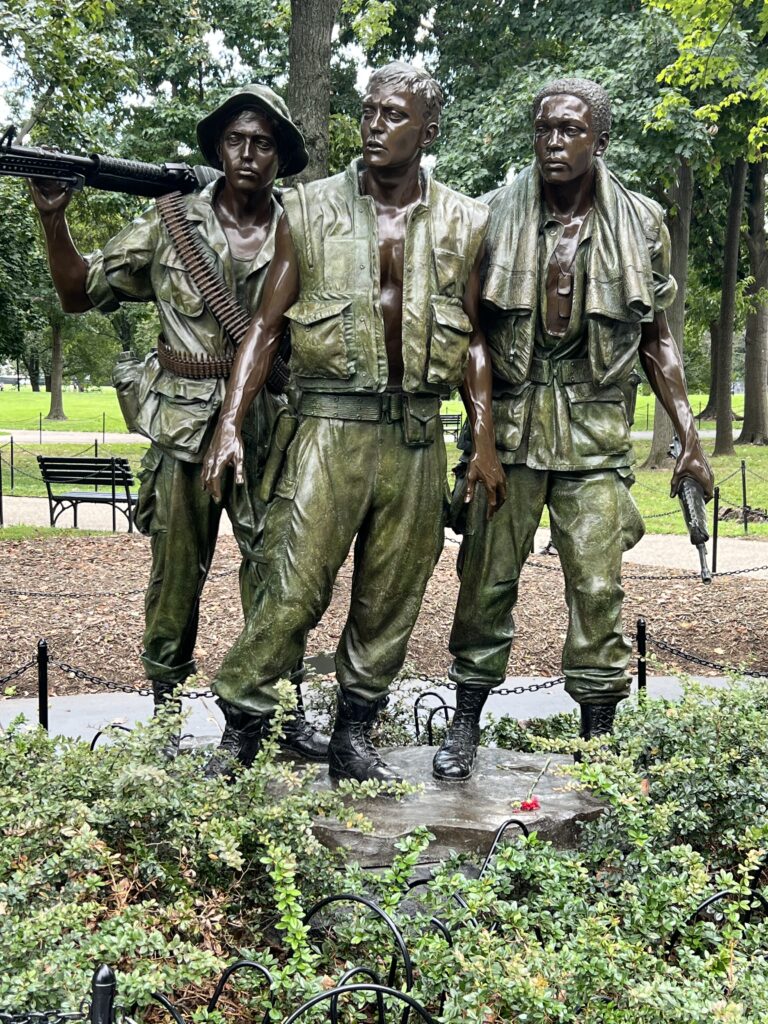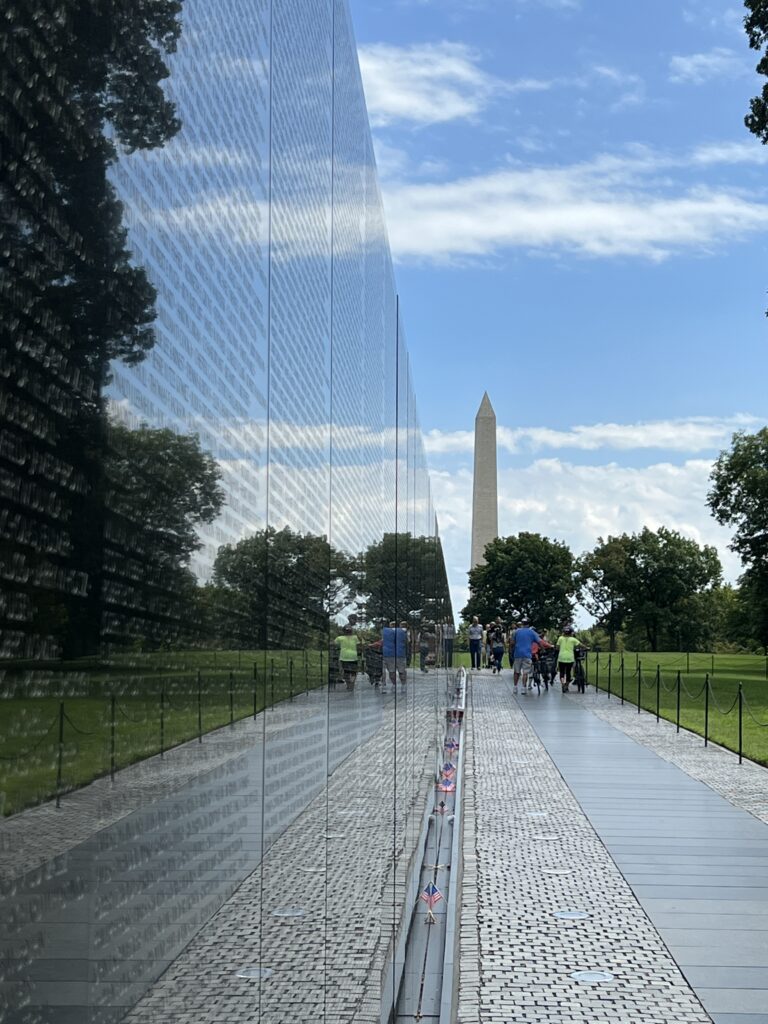There is just so much to see here that trying to prioritize where to go next can be daunting! We’re fortunate that having Steppin’ Out docked so close to the center of all of the action makes it easy to see many of the Memorials and Museums.
So we headed back over to the National Mall to pick up where we left off after the Lincoln Memorial. Walking back to the Northeast we came across the Vietnam Memorial which was busy with folks walking along and many searching for a specific name. You would find at the base of the wall under some panels items that someone had left behind, many with a note included. There were a few Purple Hearts left here and I could only imagine the emotions running thru the individuals that left those behind.
I didn’t know before hand that the memorial is laid out in chronological order of the soldiers that died during the Vietnam war. This gives it the tapered look where the panels are shorter on the ends and the tallest in the middle, representing the height of the war and also the most deaths of U.S. Soldiers. It was a humbling sight to see during the day but we came back a few nights later and found it to be an even more impressive tribute to those who lost their life in Vietnam.
Check here for more info: https://www.nps.gov/vive/index.htm





Directly south of the Vietnam War Memorial is the recently renovated Korean War Memorial. We had not seen it in its prior form but wow, what an amazing job they did with the renovation!
“A Place of Reflection” Viewed from above, the memorial is a circle intersected by a triangle. Visitors approaching the memorial come first to the triangular Field of Service. Here, a group of 19 stainless-steel statues, crated by World War II veteran Frank Gaylord, depicts a squad on patrol and evokes the experience of American ground troops in Korea. Strips of granite and scrubby juniper bushes suggest the rugged Korean terrain, while windblown ponchos recall the harsh weather. This symbolic patrol brings together members of the US Air Force, Army, Marines and Navy; the men are portrayed from a variety of ethnic backgrounds.
A granite curb on the north side of the statues lists the 22 countries of the United Nations that sent troops or gave medical support in defense of South Korea. On the south side is a black granite wall. Its polished surface mirrors the statues, intermingling the reflected images with the faces etched into the granite. The etched mural is based on actual photographs of unidentified American soldiers, sailors, airmen and Marines. The faces represent all those who provided support for the ground troops. Together these images reflect the determination of the U.S. forces and the countless ways in which Americans answered their country’s call to duty.
The adjacent Wall of Remembrance and Pool of Remembrance, encircled by a grove of trees, provides a quiet setting. The wall includes the names of 36,574 American servicemen and more than 7,200 members of the Korean Augmentation to the United States Army who gave their lives defending the people of South Korea. Numbers of those killed, wounded, missing in action, and held prisoner of war are etched in stone nearby. Opposite this counting of the war’s toll, another granite wall bears a message inlaid in silver: “Freedom is Not Free.”
For more information, click here: https://www.nps.gov/kowa/index.htm





There is just so much to see and do while here that getting to all of it will take weeks or months! Fortunately, we have Steppin’ Out to head back to every afternoon to recharge and plan for the next day! On our way back to the boat, we found ourselves walking by the Jefferson Memorial. Thomas Jefferson was one of the authors of our Declaration of Independence, a statesman and visionary!
Dedicated by President Franklin Delano Roosevelt on April 13, 1943, the Thomas Jefferson Memorial stands in a straight line with the White House. Architect John Russell Pope, influenced by Jefferson’s taste in classical architecture, echoed the style seen in Jefferson’s two most famous buildings – Monticello and the University of Virginia Rotunda.
The Jefferson Memorial building is a circular, open-air structure featuring a shallow dome supported by a circular colonnade composed of 26 Ionic columns. An additional 12 columns support the north portico, and 4 columns stand in each of the memorials 4 openings. The memorial is constructed of white Imperial Danby marble from Vermont and it rests upon a series of granite and marble-stepped terraces. A flight of granite and marble stairs and platforms, flanked by granite buttresses, lead up from the Tidal Basin. The stairs rise to a portico with a triangular pediment, which features a sculpture by Adolph A. Weinman, depicting the five members of the drafting committee of the Declaration of Independence submitting their report to Congress. A dentiled cornice with an egg and dart molding surrounds the pediment, below which is a plain frieze.






Four quotations from Jefferson’s writings are carved into the walls of the memorial chamber. An excerpt from the Declaration of Independence, the document for which Jefferson is best known, is located on the southwest wall. The southeast wall features a statement on the evolution of law and the constitution, which was taken from a letter written to Samuel Kercheval in 1816.
The northwest wall is inscribed with a combination of six quotations taken primarily from Jefferson’s “1786 Notes of Virginia” and “Summary Views,” which illustrate his beliefs in the evils of slavery and the need to educate the masses. The northeast wall contains a quote from the “Act of Religious Freedom,” which was adopted in 1779 and eliminated the state church of Virginia; this quote expresses Jefferson’s views on freedom of religion.
For more information on the Jefferson Memorial, click here: https://www.nps.gov/thje/index.htm

